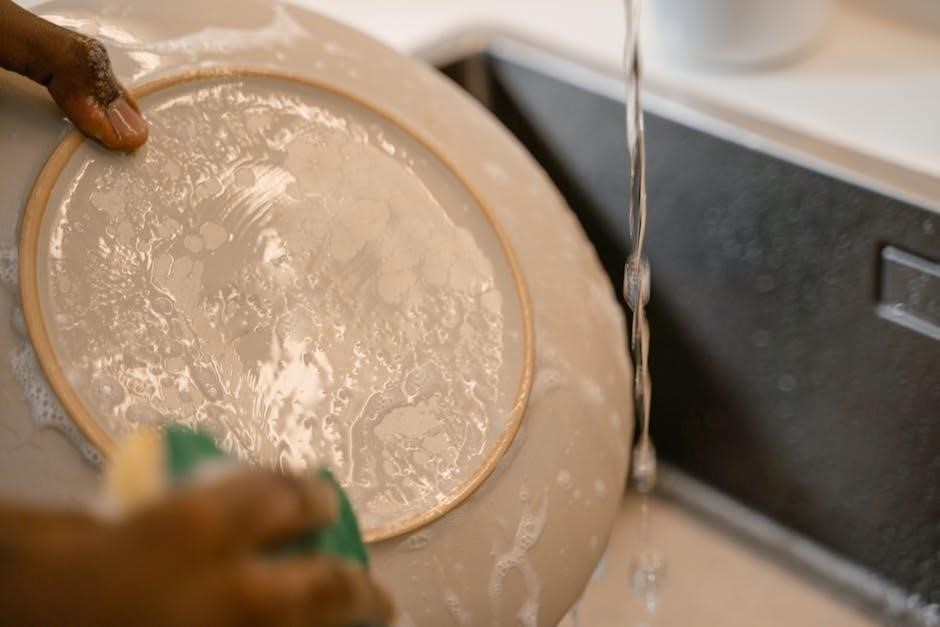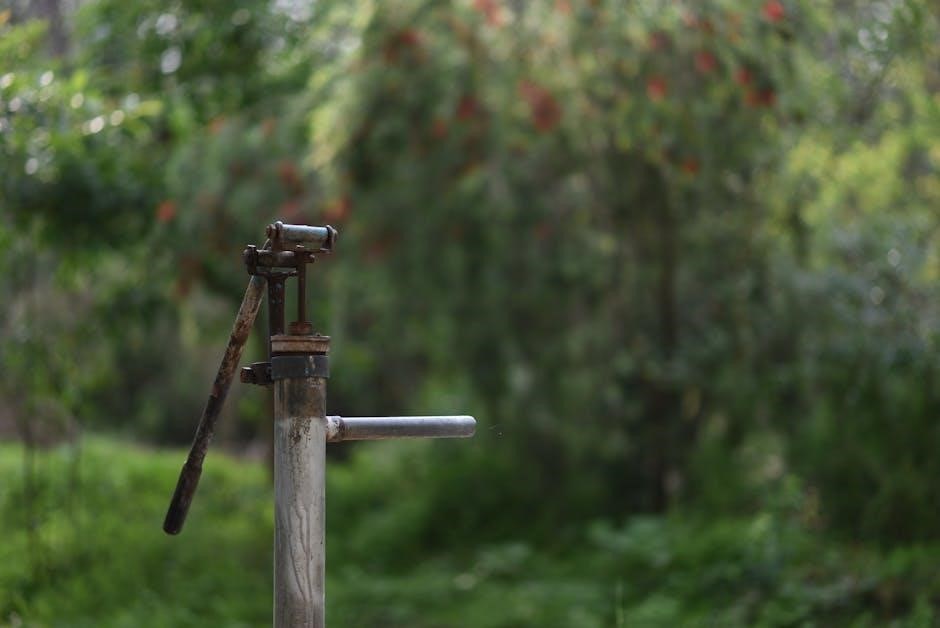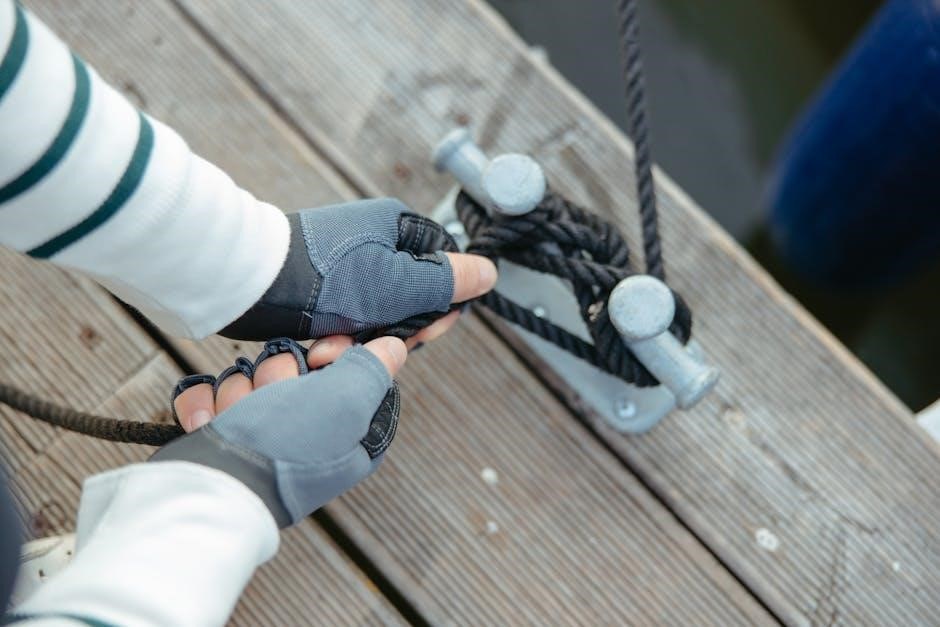Manual water pumps are hand-operated pumps with hoses used to remove water from boats, requiring specific regulations and specifications to ensure safety and efficiency always met properly online.
Definition and Purpose
A manual water pump is a device used to remove water from a boat, typically in emergency situations or for maintenance purposes. The purpose of a manual water pump is to provide a reliable and efficient means of removing water from the bilge, which is the lowest compartment on a boat. This is especially important for sailboats and powerboats, as excessive water in the bilge can lead to stability issues and potentially cause the boat to capsize. A manual water pump is designed to be hand-operated, with a hose that can be used to direct water out of the boat. The definition of a manual water pump encompasses its function, which is to provide a safe and effective means of removing water from a boat, and its purpose is to ensure the safety and stability of the vessel. Manual water pumps are essential equipment for many types of boats.
Types of Boats Requiring Manual Water Pumps
According to regulations, sailboats and powerboats between 9 and 12 meters in length are required to carry a manual water pump on board. This is a crucial safety measure to ensure that these vessels can remove water from the bilge in emergency situations. The size and type of boat determine the need for a manual water pump, with larger boats requiring more advanced pumping systems. Smaller boats, on the other hand, may not require a manual water pump if they are designed with sealed watertight compartments. The regulations specify the types of boats that must carry a manual water pump, and it is essential for boat owners to be aware of these requirements to ensure compliance and safety. Boat owners must check the regulations to determine if their vessel requires a manual water pump. This information is readily available online.

Types of Bilge Pumps
Centrifugal and diaphragm pumps are common types of bilge pumps used online always.
Centrifugal Pumps
Centrifugal pumps are a type of pump that uses kinetic energy to move water. They are commonly used in boats to remove water from the bilge. These pumps work by using a spinning impeller to accelerate the water, which is then forced out of the pump by its own momentum. Centrifugal pumps are relatively inexpensive and can pump a lot of water, making them a popular choice for many boat owners. They are also designed to operate while completely submerged, which makes them well-suited for use in boats. Overall, centrifugal pumps are a reliable and efficient option for removing water from the bilge, and are an important part of many boat’s safety equipment. They are widely available and can be easily installed on most boats, making them a great option for anyone looking to upgrade their boat’s safety features.
Diaphragm Pumps
Diaphragm pumps are another type of pump used to remove water from boats. They work by using a flexible diaphragm to create a vacuum, which draws water into the pump. The diaphragm then contracts, forcing the water out of the pump. Diaphragm pumps are known for their reliability and ability to handle debris and other solids that may be present in the water. They are also relatively low maintenance and can be easily repaired if needed. Diaphragm pumps are a good option for boats that need to remove water from the bilge, and are often used in conjunction with other types of pumps. They are widely available and can be easily installed on most boats, making them a popular choice for many boat owners who need a reliable and efficient way to remove water. They are suitable for various applications.

Requirements for Manual Water Pumps
Manual water pumps must meet specific regulations and safety standards always properly.
Regulations and Specifications
Manual water pumps are subject to specific regulations and specifications to ensure safety and efficiency. These regulations vary depending on the length and type of vessel. For example, sailboats and powerboats between 9 and 12 meters in length must carry a manual water pump on board. The regulations also specify the minimum capacity requirements for manual water pumps, which is typically measured in liters per minute. Additionally, the regulations require that manual water pumps be made of durable materials and be designed to operate effectively in a variety of conditions. The specifications for manual water pumps are outlined in detail in the relevant maritime regulations and guidelines. Overall, the regulations and specifications for manual water pumps play a critical role in ensuring the safety of vessels and their occupants. Manual water pumps must meet these requirements to be considered compliant.
Length and Capacity Requirements
Manual water pumps have specific length and capacity requirements. Vessels between 9 and 12 meters in length must have a manual water pump with a minimum capacity. The capacity is typically measured in liters per minute. For larger vessels, the capacity requirements increase. For example, vessels over 19.8 meters in length require a minimum capacity of 190 liters per minute. The length and capacity requirements are outlined in maritime regulations; These requirements ensure that vessels have adequate equipment to remove water in emergency situations. The regulations also consider the type of vessel and its intended use. Overall, the length and capacity requirements for manual water pumps are critical to ensuring the safety of vessels and their occupants. The requirements vary depending on the vessel’s size and type, and must be met to ensure compliance.

Effectiveness of Manual Water Pumps
Manual water pumps are very fast and effective at removing water from vessels always meeting safety standards online properly.
Speed and Efficiency
Manual water pumps are designed to be fast and efficient at removing water from boats, with some pumps able to remove large amounts of water quickly.
The speed and efficiency of manual water pumps are crucial in emergency situations, where every minute counts.
Manual water pumps are often used in conjunction with other safety equipment, such as life jackets and flares, to ensure the safety of passengers and crew.
The effectiveness of manual water pumps depends on various factors, including the size of the pump, the length of the hose, and the amount of water being removed.
Overall, manual water pumps are an essential piece of safety equipment for any boat, and their speed and efficiency are critical in preventing accidents and saving lives.
The use of manual water pumps is regulated by safety standards and regulations, which dictate the minimum requirements for manual water pumps on boats.
Bailers and Bilge Pumping Requirements
Bailers and manual bilge pumps are essential for removing water from boats, and their requirements are based on the length of the vessel.
The regulations specify that a bailer or manual bilge pump is not required for a boat if it cannot hold enough water to make it capsize.
Additionally, boats fitted with sealed watertight compartments are also exempt from this requirement.
The use of bailers and manual bilge pumps is critical in preventing accidents and saving lives.
Boat owners and operators must ensure that their vessels are equipped with the necessary bailers and manual bilge pumps to meet the regulatory requirements.
The requirements for bailers and manual bilge pumps vary depending on the type and size of the boat, and it is essential to consult the relevant regulations to determine the specific requirements for each vessel.
Overall, bailers and manual bilge pumps play a crucial role in boat safety.

Additional Requirements and Specifications
Manual water pumps have specific capacity requirements and regulations to ensure safety and efficiency always.
Minimum Capacity Requirements
Manual water pumps must meet specific minimum capacity requirements to ensure effective water removal from boats. The capacity requirements vary depending on the length and type of vessel. For example, vessels over 19.8 meters in length require a minimum capacity of 190 liters per minute. Smaller vessels, on the other hand, require a minimum capacity of 95 liters per minute. Additionally, vessels with more than 49 passengers require a minimum capacity of 95 liters per minute. These requirements are in place to ensure that manual water pumps can effectively remove water from the vessel in the event of an emergency. The minimum capacity requirements are an important consideration for boat owners and operators, as they must ensure that their manual water pump meets the necessary standards. This is crucial for maintaining safety and preventing accidents.
Portable Hand Pump Requirements
Portable hand pumps are a crucial component of a manual water pump system, and they must meet specific requirements. According to regulations, a portable hand pump is required for vessels with more than 49 passengers and all ferry vessels. The portable hand pump must have a minimum capacity of 38 liters per minute. This requirement ensures that the pump can effectively remove water from the vessel in the event of an emergency. The portable hand pump must also be easily accessible and ready for use at all times. Additionally, the pump must be designed to operate efficiently and effectively in a variety of conditions. By meeting these requirements, portable hand pumps can play a vital role in maintaining the safety of vessels and their occupants. Regular inspection and maintenance of the pump are also essential to ensure its proper functioning.


